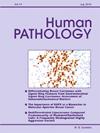Primary urethral adenocarcinoma harbors recurrent KRAS and EGFR alterations
IF 2.7
2区 医学
Q2 PATHOLOGY
引用次数: 0
Abstract
Primary urethral adenocarcinoma is an extremely rare malignancy with an unclear pathogenesis. Previously, we reported 4 brachytherapy-associated (BA) urethral mucinous adenocarcinomas that developed following treatment for prostate cancer. In the present study, we report one additional BA and 3 radiation-independent (RI) urethral adenocarcinomas. The aim of this study is to explore the molecular alterations and to compare the clinicopathologic features.
RNA sequencing was performed on 5 tumors, and a next-generation sequencing (NGS)-based fusion assay was used to identify gene fusions in 6 tumors. Additionally, NGS-based targeted genomic DNA sequencing was employed to analyze one metastatic BA tumor and one metastatic RI tumor.
The 8 patients had a mean age of 67 (range: 37–87) years, with one being female in the RI cohort. Cystoscopy revealed the following urethral findings: a papillary lesion (4/7), mass causing obstruction (1/7) and irregular friable tissue (2/7). Seven patients underwent urethrectomy with cystectomy/prostatectomy/hysterectomy. The mean tumor size was 3.4 cm (range: 1.5–6.5). Adenocarcinoma in situ was noted in 5 tumors. All 5 BA tumors originated from the prostatic urethra, with 4 showing mucinous morphology and one enteric morphology, and showed moderate to poor differentiation and tumor stages of pT2 (2/4), pT3 (1/3) and pT4 (1/4). Two patients developed metastasis, one at 3.3 and one at 4.2 years after diagnosis, and all patients were alive at a median follow-up of 4.5 (range: 2–14) years. In contrast, 3 RI tumors arose from bulbar, prostatic, or female mid/distal urethra, presenting as enteric, mucinous, and not otherwise specified (NOS) subtypes, with well to moderate differentiation and a tumor stage of pT4 (2/2). Two died of the disease, while one was alive without disease at a median follow-up of 4 (range: 2.2–14.5) years. All tumors were diffusely positive for CK20, CDX2 (7/7), and AMACR (3/3), and lacked nuclear β-catenin expression (5/5). Most expressed CK7 (5/7). KRAS mutations (p.Gly12Val and p.Gly13Asp) were observed in one BA mucinous tumor and one RI NOS tumor with the p.Gly13Asp mutation also detected in the metastatic RI tumor. The EGFR p.Ser784Phe mutation was detected in one RI enteric tumor. TP53 p.Val172Phe, CDKN2A p.Leu32_Leu37del, and amplifications of EGFR and MDM2, were identified in a metastatic BA enteric tumor. No fusion transcripts were identified.
In conclusion, urethral adenocarcinoma harbors recurrent KRAS and EGFR alterations, independent of prior radiotherapy. RI tumors appear to be associated with a worse prognosis compared to BA tumors.
原发性尿道腺癌含有复发性KRAS和EGFR改变
原发性尿道腺癌是一种非常罕见的恶性肿瘤,其发病机制尚不清楚。先前,我们报道了4例近距离治疗相关(BA)尿道粘液腺癌,这些癌是在前列腺癌治疗后发生的。在本研究中,我们报告了1例BA和3例辐射无关(RI)尿道腺癌。本研究的目的是探讨分子改变和比较临床病理特征。对5个肿瘤进行RNA测序,并采用基于下一代测序(NGS)的融合实验对6个肿瘤进行基因融合鉴定。此外,采用基于ngs的靶向基因组DNA测序对1例转移性BA肿瘤和1例转移性RI肿瘤进行分析。8例患者的平均年龄为67岁(范围:37-87),其中1例为RI队列中的女性。膀胱镜检查结果如下:乳头状病变(4/7),肿块引起阻塞(1/7),不规则易碎组织(2/7)。7例患者行尿道切除术并膀胱切除术/前列腺切除术/子宫切除术。肿瘤平均大小3.4 cm(范围1.5 ~ 6.5)。5例原位腺癌。5例BA肿瘤均起源于前列腺尿道,其中4例呈黏液形态,1例呈肠状形态,pT2(2/4)、pT3(1/3)、pT4(1/4)分化中低,肿瘤分期为pT2(2/4)。2例患者发生转移,1例在诊断后3.3年,1例在4.2年,所有患者中位随访时间为4.5年(范围:2-14年)。相比之下,3例RI肿瘤发生于球部、前列腺或女性尿道中/远端,表现为肠型、黏液型和非特异性(NOS)亚型,分化良好至中度,肿瘤分期为pT4(2/2)。中位随访时间为4年(范围:2.2-14.5年),其中2例死于该病,1例无病存活。所有肿瘤均弥漫性阳性表达CK20、CDX2(7/7)和AMACR(3/3),细胞核缺乏β-catenin表达(5/5)。表达最多的是CK7(5/7)。在1例BA黏液瘤和1例RI NOS肿瘤中观察到KRAS突变(p.Gly12Val和p.Gly13Asp),在转移性RI肿瘤中也检测到p.Gly13Asp突变。在一例RI肠肿瘤中检测到EGFR p.Ser784Phe突变。TP53 p.Val172Phe, CDKN2A p.Leu32_Leu37del,以及EGFR和MDM2的扩增在转移性BA肠肿瘤中被鉴定出来。未发现融合转录本。总之,尿道腺癌具有复发性KRAS和EGFR改变,与既往放疗无关。与BA肿瘤相比,RI肿瘤的预后似乎更差。
本文章由计算机程序翻译,如有差异,请以英文原文为准。
求助全文
约1分钟内获得全文
求助全文
来源期刊

Human pathology
医学-病理学
CiteScore
5.30
自引率
6.10%
发文量
206
审稿时长
21 days
期刊介绍:
Human Pathology is designed to bring information of clinicopathologic significance to human disease to the laboratory and clinical physician. It presents information drawn from morphologic and clinical laboratory studies with direct relevance to the understanding of human diseases. Papers published concern morphologic and clinicopathologic observations, reviews of diseases, analyses of problems in pathology, significant collections of case material and advances in concepts or techniques of value in the analysis and diagnosis of disease. Theoretical and experimental pathology and molecular biology pertinent to human disease are included. This critical journal is well illustrated with exceptional reproductions of photomicrographs and microscopic anatomy.
 求助内容:
求助内容: 应助结果提醒方式:
应助结果提醒方式:


